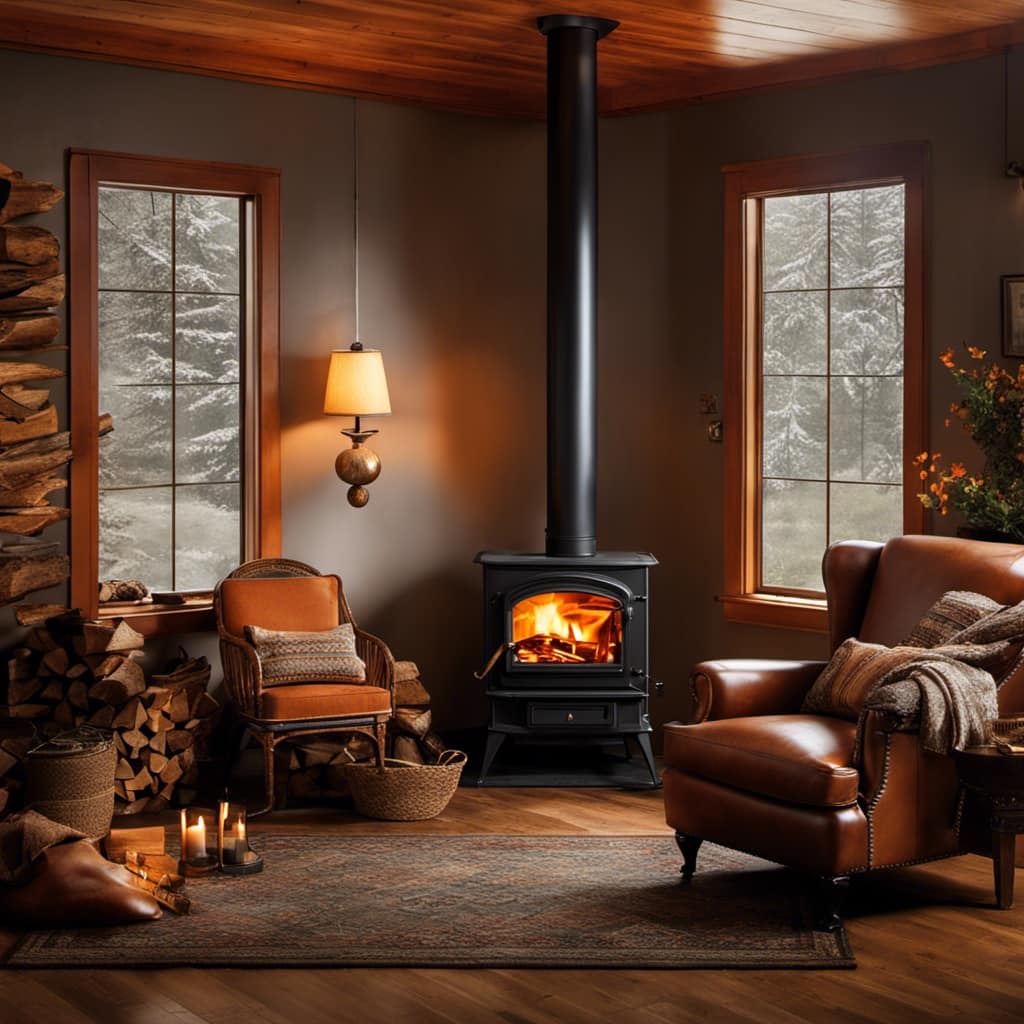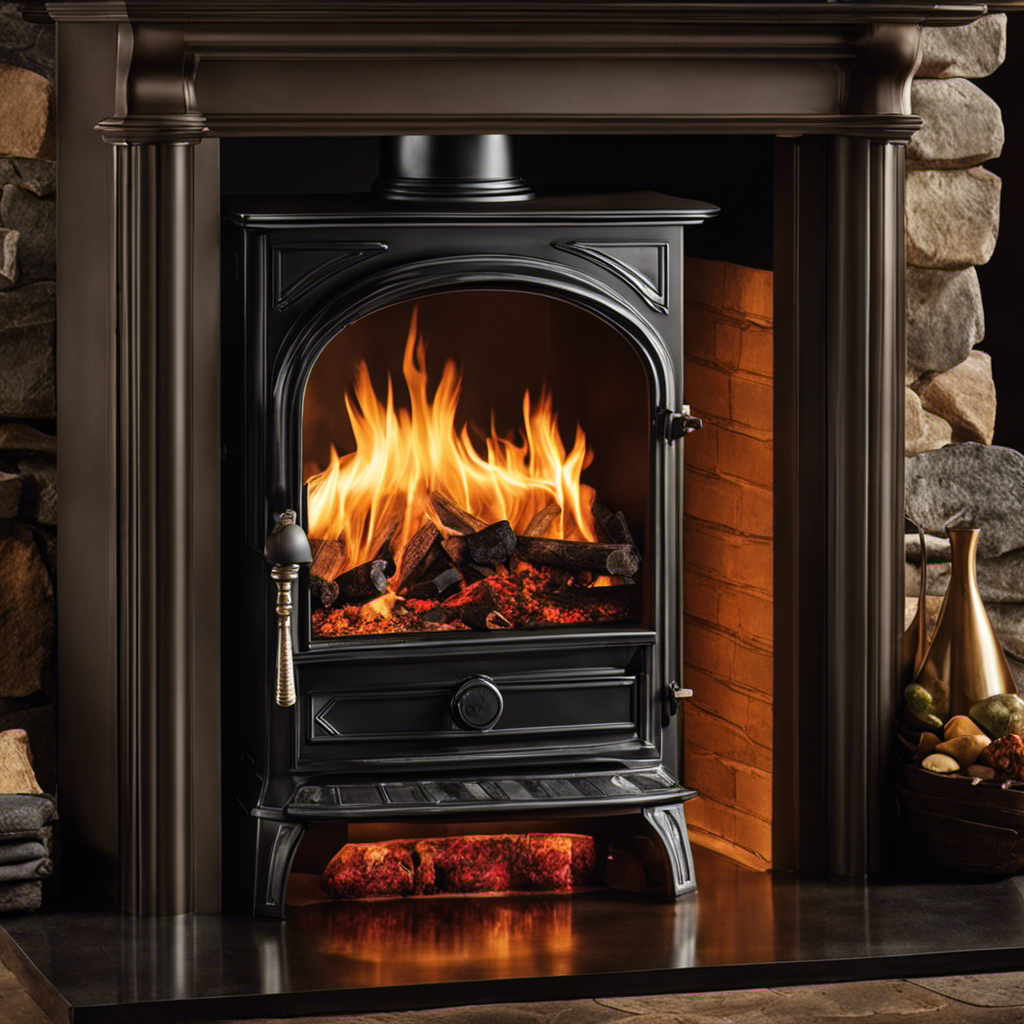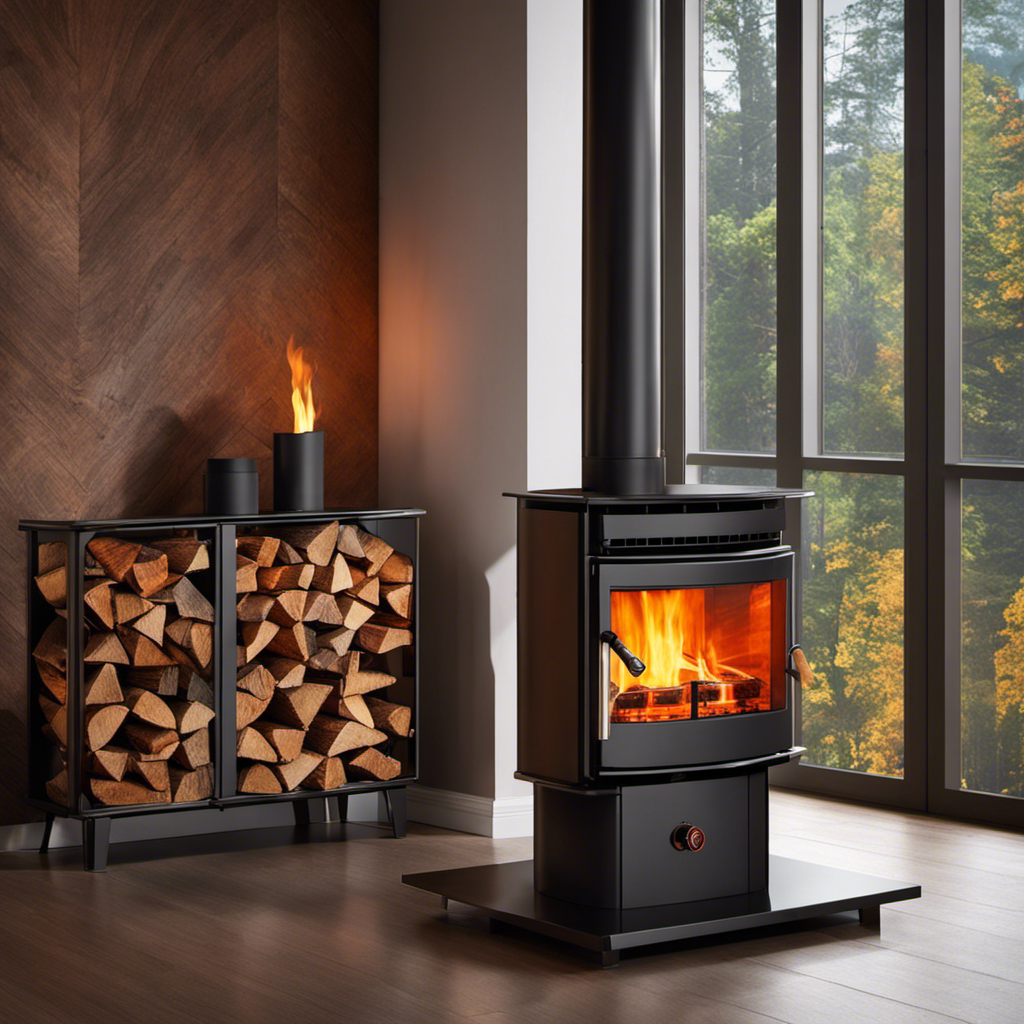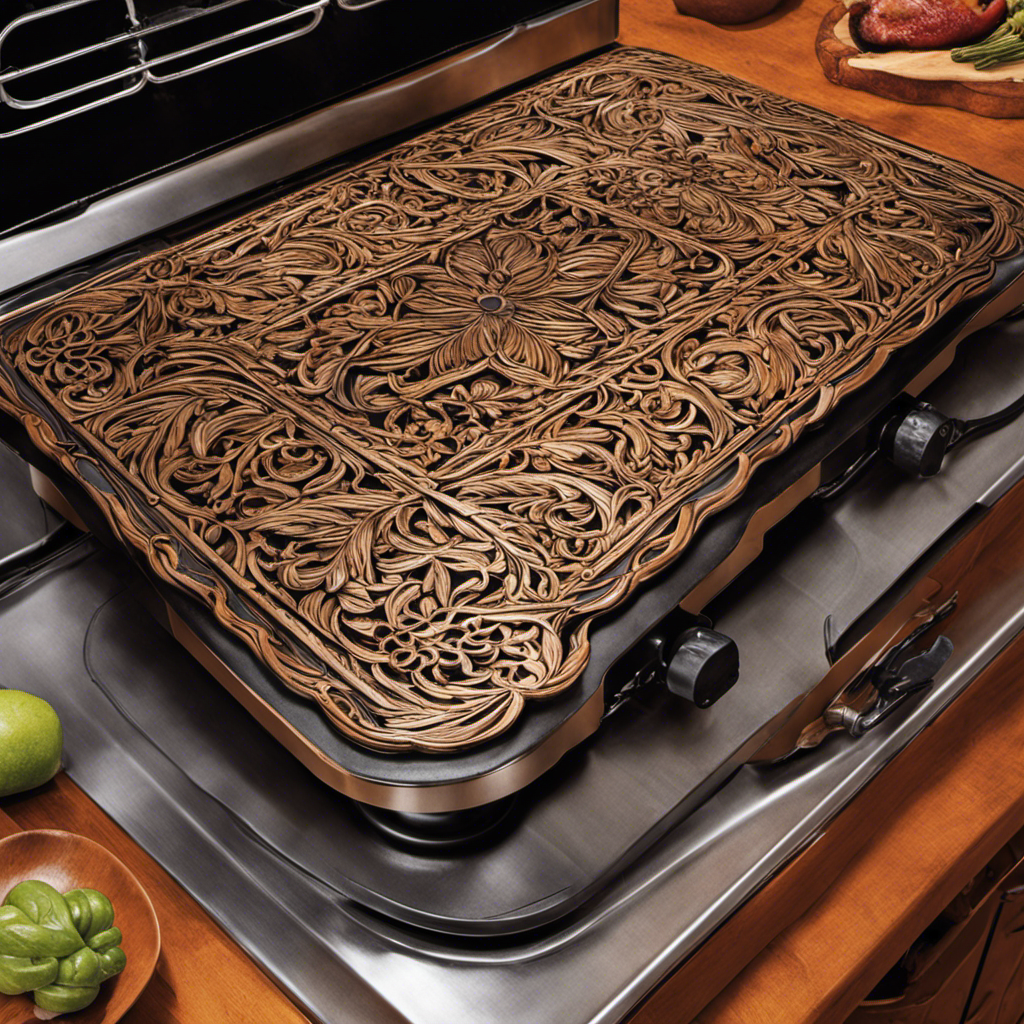
As I entered my living room, I was met with a dense cloud of smoke coming from my wood stove, causing concern. My anxiety grew as I questioned why my reliable heating source was now a worry.
Translated into US English: As I walked into my living room, I was greeted by a thick cloud of smoke billowing threateningly from my wood stove. My anxiety surged as I wondered why my trusty heating source had suddenly become a source of concern.
In this article, we will delve into the possible reasons behind your wood stove smoking.
From a blocked chimney or poor ventilation to improper installation or excessive creosote buildup, we’ll explore the technical explanations and solutions to ensure your wood stove functions properly once again.
Key Takeaways
- Regular chimney inspections and cleanings are essential to prevent smoke issues and remove creosote buildup.
- Adjusting the air intake and draft control of the wood stove can help address smoke problems.
- Choosing the right size stove and proper insulation are crucial for optimal performance and minimizing smoke emissions.
- Using well-seasoned firewood with moisture content below 20% reduces the production of creosote and smoke.
Blocked Chimney or Flue
I think my chimney might be blocked because my wood stove is smoking. Chimney maintenance is crucial for the proper functioning of a wood stove. Over time, creosote and soot can build up inside the chimney, obstructing the flow of smoke and causing it to back up into the house. Clearing obstructions is essential to prevent smoke from entering your living space and ensure the efficient operation of your wood stove.

To address a blocked chimney, it’s recommended to hire a professional chimney sweep who can perform a thorough cleaning. They’ll use specialized brushes and tools to remove any accumulation of creosote, soot, or debris that may be obstructing the flue. This process not only improves the airflow but also reduces the risk of chimney fires.
Regular chimney maintenance is essential to prevent blockages. It’s advisable to have your chimney inspected and cleaned at least once a year, especially if you use your wood stove frequently. Additionally, using properly seasoned firewood can minimize the buildup of creosote in the first place.
Now, let’s move on to the next section where we’ll discuss the potential issues related to poor airflow or ventilation.
Poor Airflow or Ventilation
When it comes to wood stove performance, poor airflow or ventilation can cause a multitude of issues.

Insufficient combustion air can lead to incomplete burning, resulting in decreased heat output and increased smoke production.
Additionally, using a stove that’s too large for the space can restrict airflow, leading to inefficient combustion.
Blocked Chimney or Flue
My wood stove is smoking because the chimney or flue may be blocked. When the chimney or flue becomes obstructed, it prevents the proper flow of smoke and gases out of the stove, causing smoke to fill the room instead. To address this issue, it is important to conduct regular flue cleaning and chimney inspections. These tasks involve removing any debris or buildup that may have accumulated in the chimney or flue over time. By doing so, you can ensure that the airflow remains unobstructed, preventing smoke from entering your living space. Regular maintenance and inspections are essential to keep your wood stove functioning efficiently and safely. Refer to the table below for a summary of the key points regarding flue cleaning and chimney inspection.
| Flue Cleaning | Chimney Inspection |
|---|---|
| Removes debris and buildup | Identifies any blockages or damage |
| Ensures proper airflow | Ensures safe operation |
| Prevents smoke from filling the room | Detects potential hazards |
| Should be done regularly | Should be done annually |
Insufficient Combustion Air
The lack of sufficient combustion air can hinder the proper functioning of a wood stove. Combustion efficiency is crucial for a wood stove to operate effectively and produce less smoke. When there isn’t enough air available for combustion, incomplete burning occurs, resulting in smoke production.

To address this issue, it’s important to adjust the air intake of the wood stove. By increasing the air intake, more oxygen will be supplied to the fire, promoting complete combustion and reducing smoke. On the other hand, decreasing the air intake can help control the fire and reduce heat output.
Finding the right balance between air intake and combustion efficiency is key to achieving optimal performance from a wood stove and minimizing smoke emissions.
Wrong Size Stove
I found that the wrong size stove doesn’t heat my home efficiently. When it comes to wood stoves, finding the right size is crucial for optimal performance. A stove that is too small will struggle to generate enough heat, while a stove that is too large can overheat the space and waste energy. To ensure proper insulation, it is important to choose a stove that matches the size and layout of your home. Here is a table that can help you determine the right size stove for your space:
| Area (sq ft) | Stove Size (BTUs) |
|---|---|
| 500-1,000 | 20,000-35,000 |
| 1,000-1,500 | 35,000-50,000 |
| 1,500-2,000 | 50,000-70,000 |
| 2,000-2,500 | 70,000-90,000 |
| 2,500+ | 90,000+ |
Wet or Green Firewood
Using wet or green firewood can cause my wood stove to smoke. When the firewood isn’t properly seasoned or dried, it contains a high moisture content. As a result, the fire doesn’t burn efficiently, leading to a smoky fire and increased smoke production. To prevent this issue, it’s crucial to use dry firewood that has been properly seasoned for at least six months.

Here are three important factors to consider for wood stove maintenance and preventing smoking issues:
-
Properly season firewood: Seasoning firewood involves drying it out to reduce its moisture content. This can be done by storing the firewood in a dry, well-ventilated area for at least six months. Dry firewood burns more efficiently, producing less smoke and reducing the likelihood of a smoky fire.
-
Store firewood correctly: It’s essential to store firewood in a dry location, preferably off the ground and protected from rain or snow. This helps to maintain the dryness of the firewood, ensuring it’s ready to be burned without causing excessive smoke.
-
Regularly clean and maintain the wood stove: Regular cleaning and maintenance of the wood stove are crucial for its optimal performance. This includes clearing any debris or creosote buildup from the stovepipe and chimney, as well as inspecting and replacing any worn-out gaskets or seals. Proper maintenance ensures proper airflow and combustion, minimizing smoke production.
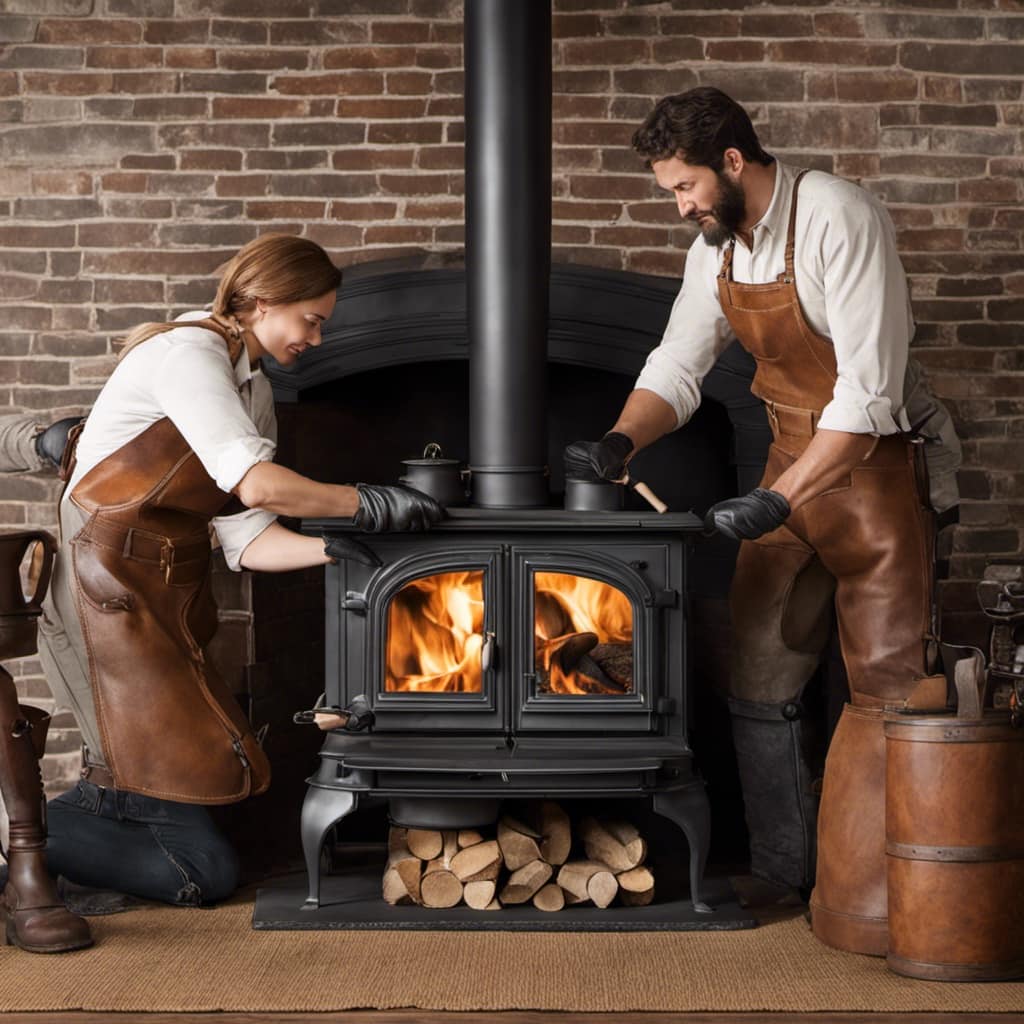
Incorrect Wood Stove Installation
I’ve seen many cases of improper wood stove installation, and it can cause a range of issues.
One common mistake is inadequate chimney ventilation, which can lead to poor draft and inefficient combustion.
Another issue is an incorrect stove pipe angle, which can cause backdrafting and allow smoke to enter the living space.
It’s crucial to ensure proper installation to avoid these problems and ensure safe and efficient operation of your wood stove.

Improper Chimney Ventilation
My wood stove is smoking because the chimney ventilation isn’t working properly. When it comes to wood stove maintenance, ensuring proper chimney ventilation is crucial. Here are three possible reasons why your chimney ventilation may not be working effectively:
-
Obstruction: A common issue is the buildup of creosote or debris in the chimney. Regular chimney maintenance, including cleaning, can prevent blockages and allow for proper ventilation.
-
Damaged or Blocked Chimney Cap: The chimney cap plays a vital role in keeping out rain, debris, and animals. If it’s damaged or blocked, it can hinder the airflow and cause smoke to back up into your home.
-
Damaged or Malfunctioning Smoke Detectors: Smoke detectors are an essential safety feature, as they can alert you to potential issues with your wood stove. Ensure your smoke detectors are in good working condition to detect any smoke or fire hazards.

Now that we’ve covered improper chimney ventilation, let’s move on to the next subtopic: incorrect stove pipe angle.
Incorrect Stove Pipe Angle
When the stove pipe angle is incorrect, it can lead to poor ventilation and potential smoke issues. The stove pipe, also known as the chimney connector, plays a crucial role in directing the smoke from the wood stove to the chimney. If the angle of the stove pipe isn’t properly adjusted, it can create a restriction in the airflow, causing the smoke to back up into the room instead of being directed outside.
To troubleshoot this smoke issue, it’s important to ensure that the stove pipe is correctly aligned and angled. By adjusting the stove pipe to the proper angle, you can improve the ventilation and prevent smoke from escaping into your living space.
Now, let’s move on to the next section, where we’ll discuss the importance of checking for damaged or malfunctioning seals.

Damaged or Malfunctioning Seals
The smoke from my wood stove is likely due to damaged or malfunctioning seals. When the gaskets or door seal on a wood stove become damaged, they can no longer create a tight seal between the door and the stove body. As a result, smoke can escape through these openings and fill the room.
Here are three potential reasons why the seals may be damaged or malfunctioning:
-
Wear and tear: Over time, the gaskets and door seal can deteriorate due to the intense heat generated by the wood stove. Cracks, gaps, or tears in the seals can develop, allowing smoke to escape.
-
Improper installation: If the gaskets or door seal weren’t installed correctly or if they weren’t the right size for the stove, they may not provide an effective seal. This can lead to smoke leakage.

-
Lack of maintenance: Regular maintenance is essential to keep the seals in good condition. Failure to clean or lubricate the seals can cause them to deteriorate faster and become less effective at preventing smoke leakage.
Now that we’ve addressed the issue of damaged or malfunctioning seals, let’s explore the next potential cause of smoke from a wood stove: improper draft control.
Improper Draft Control
I need to adjust the draft control on my wood stove to ensure proper airflow and prevent smoke from escaping into the room. Draft control problems can often lead to smoke issues, and it’s crucial to address them promptly for the safety and comfort of your home.
Troubleshooting these problems can be relatively simple with a few key tips.

First, check if the draft control is fully open. If it’s partially closed, it restricts the airflow and can cause smoke to escape. Adjust it to the fully open position to allow maximum air intake. Additionally, make sure the control isn’t obstructed by debris or ash buildup, as this can impede its proper functioning.
Next, examine the gasket seal around the draft control. If it’s damaged or worn out, it may not create a tight seal, leading to air leaks and smoke leakage. Replace the gasket if necessary.
Furthermore, consider the chimney height and condition. If the chimney is too short or obstructed, it can cause poor draft and smoke backflow. Ensure the chimney is clear of any debris or creosote buildup, and if needed, consult a professional to assess the chimney height and make necessary adjustments.
Excessive Creosote Buildup
Excessive creosote buildup can pose a fire hazard, so it’s important to regularly inspect and clean the chimney. Creosote is a black, tar-like substance that forms when wood burns. It can accumulate in the chimney and create a blockage, reducing the efficiency of your wood stove and increasing the risk of a chimney fire.
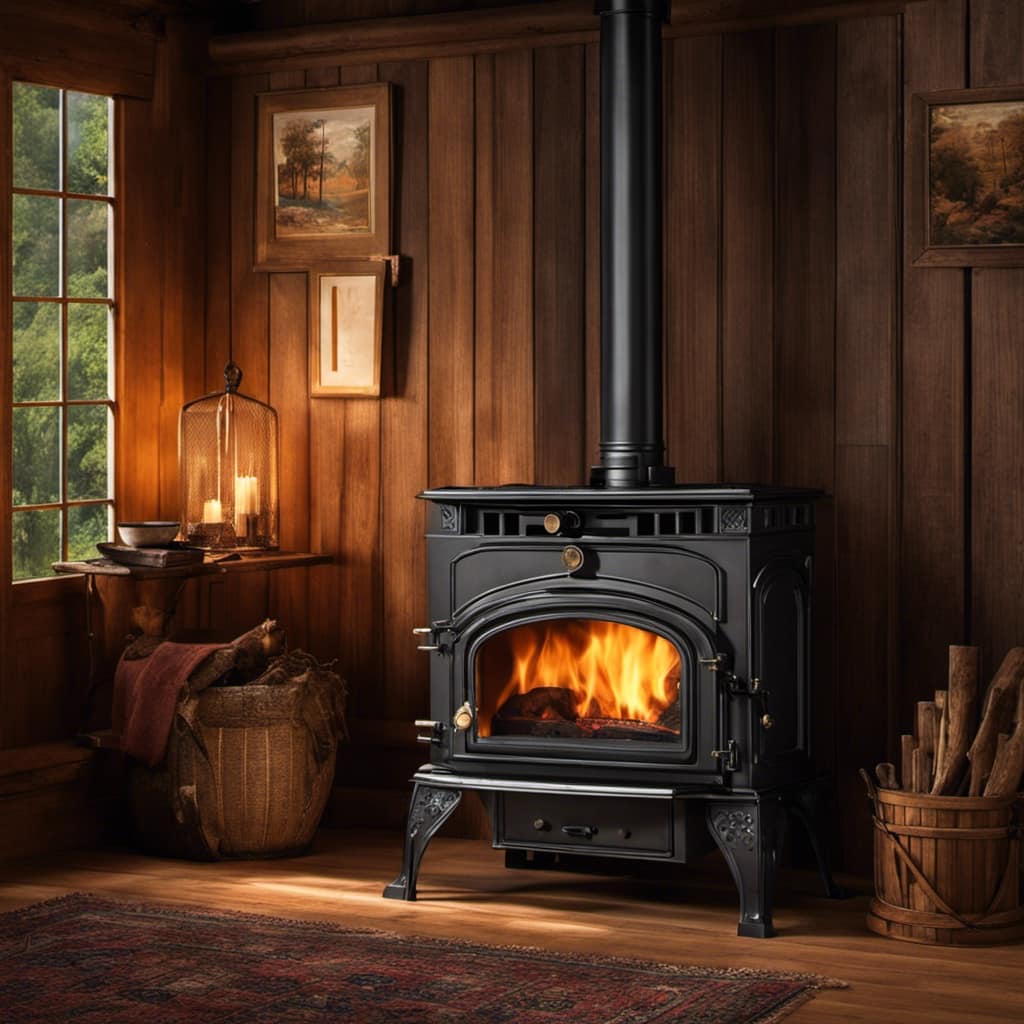
To prevent creosote buildup and maintain proper airflow, consider the following:
-
Burn dry and well-seasoned wood: Wet or unseasoned wood produces more smoke and creates more creosote. It’s crucial to use properly seasoned wood with a moisture content below 20%. This will ensure a cleaner burn and reduce creosote buildup.
-
Use the right chimney size: A chimney that’s too large for your wood stove can result in poor drafting, leading to more smoke and creosote accumulation. Consult a professional to ensure the chimney is the correct size for your stove.
-
Regular chimney inspections and cleanings: Schedule annual inspections and cleanings to remove any creosote buildup. A professional chimney sweep will thoroughly clean the chimney, removing any obstructions and minimizing the risk of chimney fires.
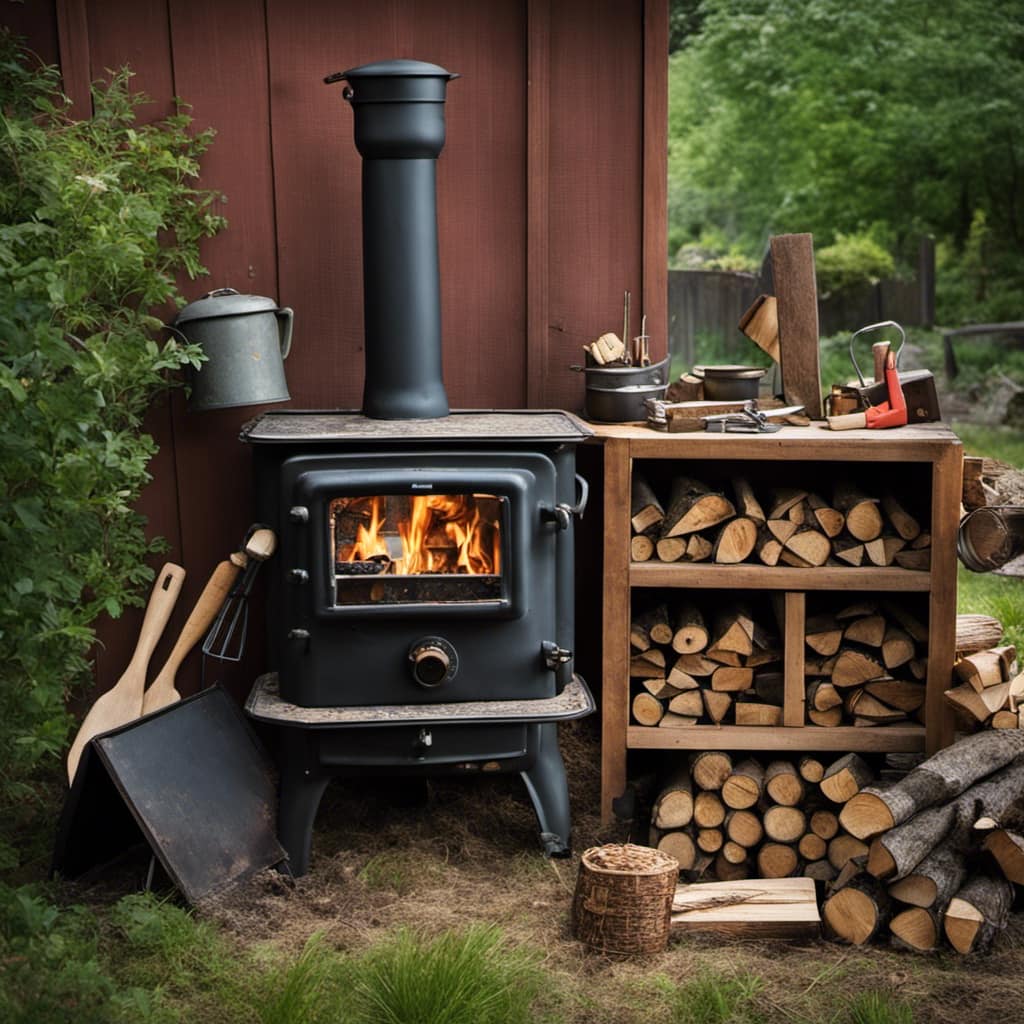
Frequently Asked Questions
How Can I Prevent Excessive Creosote Buildup in My Wood Stove?
To prevent excessive creosote buildup in your wood stove, it’s crucial to clean it regularly. Creosote, a byproduct of burning wood, can accumulate and lead to chimney fires.
To clean your wood stove, start by removing ash and debris from the firebox.
Next, scrape off any creosote buildup on the stove’s interior surfaces using a wire brush.
Finally, ensure proper ventilation and burn seasoned wood to minimize creosote production.
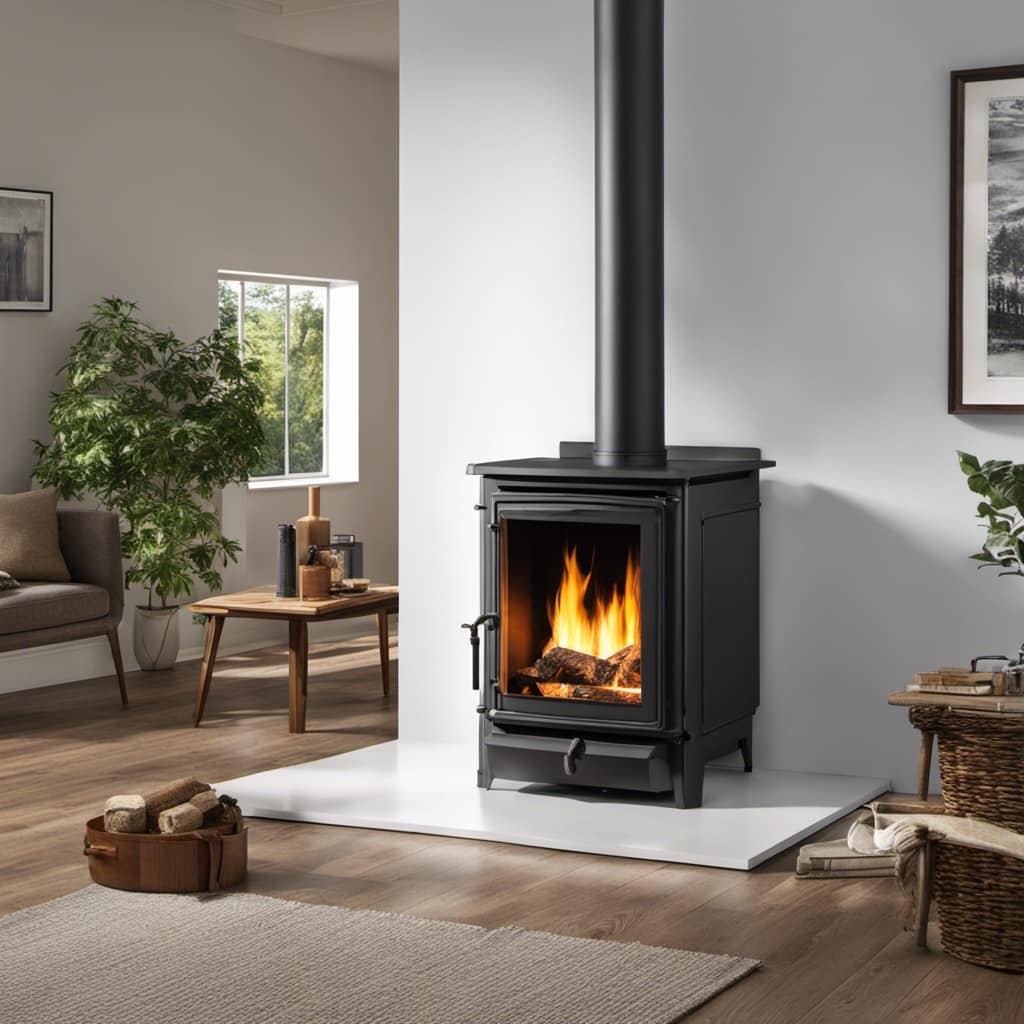
Regular cleaning and maintenance are essential for preventing creosote buildup in your wood stove.
What Are the Signs of Damaged or Malfunctioning Seals in a Wood Stove?
Signs of seal damage in a wood stove can include smoke leaking from the door, difficulty in maintaining a consistent fire, and a decrease in the stove’s efficiency. If you notice any of these signs, it’s important to fix the damaged seals as soon as possible.
This can be done by replacing the gaskets or seals around the stove door and any other areas where smoke may be escaping. Properly sealing your wood stove will help prevent smoking and improve its overall performance.
Can Using Wet or Green Firewood Cause My Wood Stove to Smoke?
Using wet or green firewood can indeed cause your wood stove to smoke. When wood has a high moisture content, it produces more smoke as it burns. This can result in poor combustion and an increase in smoke emissions.
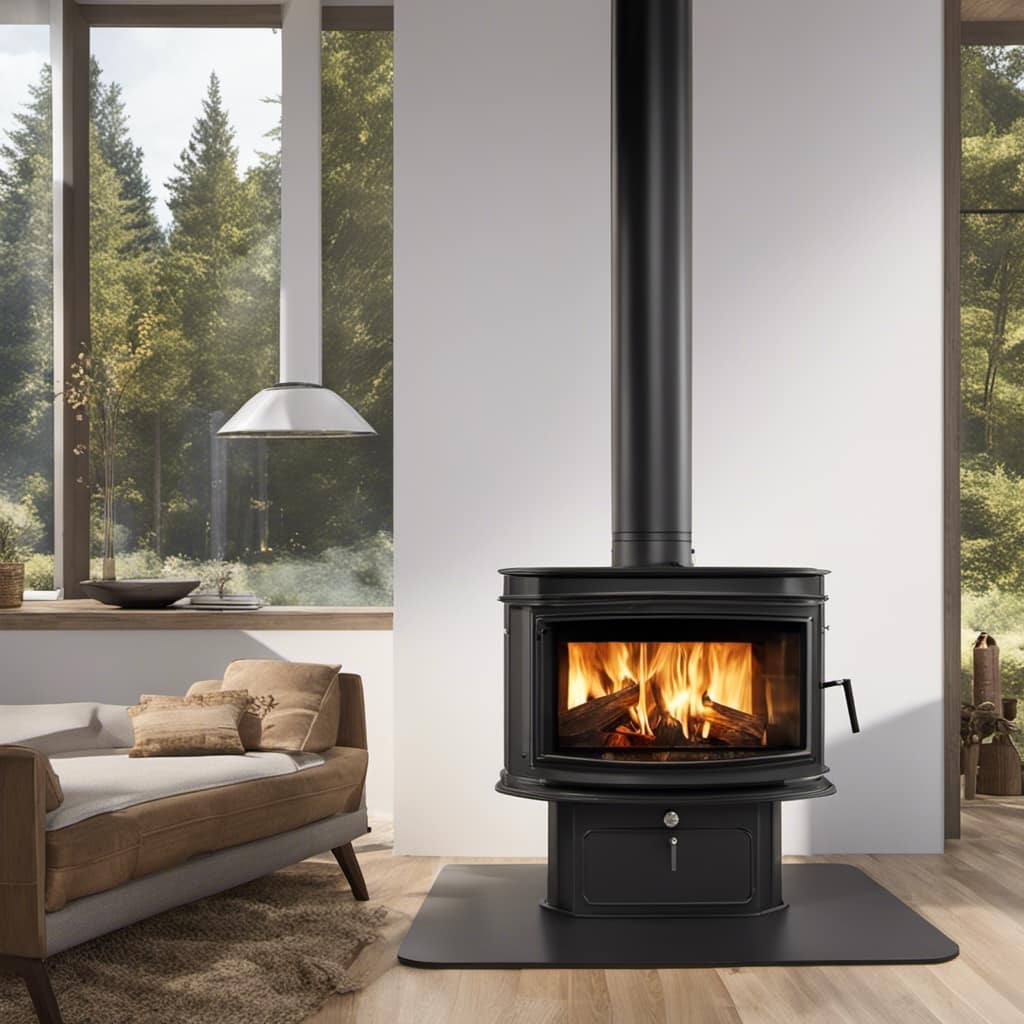
Additionally, using treated wood, such as wood that has been painted or stained, can release harmful chemicals when burned, leading to excessive smoke production.
It’s crucial to properly maintain your wood stove and only burn dry, seasoned wood to minimize smoke and ensure safe and efficient operation.
What Are the Consequences of Improper Draft Control in a Wood Stove?
When it comes to the consequences of improper draft control in a wood stove, there are a few key things to consider.
Poor draft control can lead to smoke issues, as it can cause the stove to not burn efficiently. This can result in smoke entering the room instead of being properly vented out.

To troubleshoot smoke issues, it’s important to check the damper, chimney, and airflow settings. Proper maintenance and regular cleaning can also help prevent these problems.
What Are Some Common Signs of Incorrect Wood Stove Installation?
When it comes to wood stove installation, there are some common signs that indicate improper setup. One example is inadequate ventilation, which can lead to smoking. This can occur if the chimney isn’t properly sized or if there are obstructions, such as bird nests or creosote buildup.
Other causes of wood stove smoking include a poorly designed flue or a damper that isn’t functioning correctly. Addressing these issues promptly is essential for proper wood stove operation.
Conclusion
In conclusion, addressing the issue of a wood stove smoking requires a technical understanding of its components and proper maintenance. Like a skilled mechanic diagnosing a faulty engine, troubleshooting potential causes such as blocked chimneys, poor ventilation, wet firewood, or damaged seals is crucial.

Regular inspection and cleaning to prevent excessive creosote buildup will ensure a safe and efficient wood stove that operates smoothly, like a well-oiled machine.
Growing up surrounded by the vast beauty of nature, Sierra was always drawn to the call of the wild. While others sought the comfort of the familiar, she ventured out, embracing the unpredictable and finding stories in the heartbeat of nature.
At the epicenter of every remarkable venture lies a dynamic team—a fusion of diverse talents, visions, and passions. The essence of Best Small Wood Stoves is crafted and refined by such a trio: Sierra, Logan, and Terra. Their collective expertise has transformed the platform into a leading authority on small wood stoves, radiating warmth and knowledge in equal measure.


